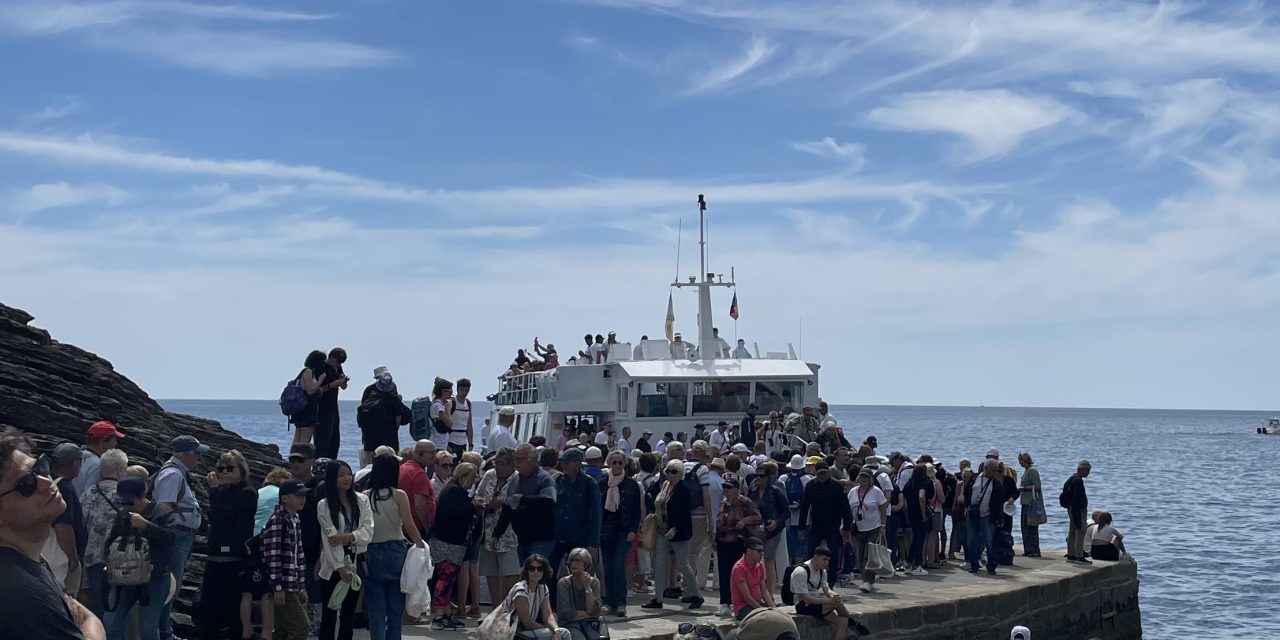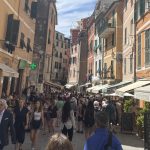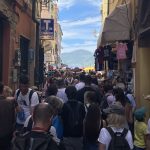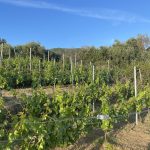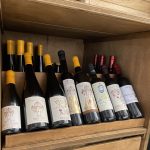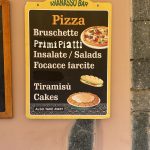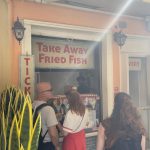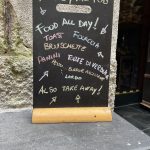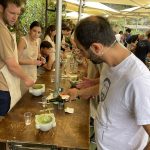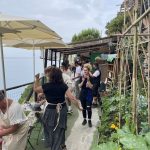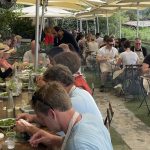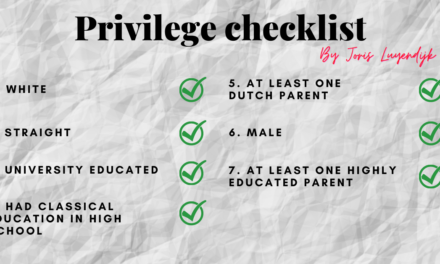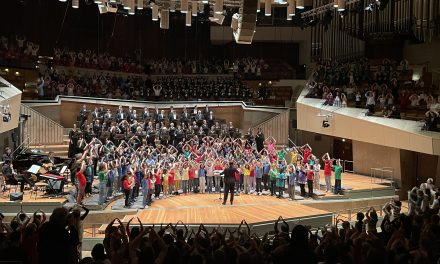Boats, trains, and busses filled with thousands of tourists arrive daily in the Cinque Terre. The five coastal cities of the Ligurian coast reside around 3,500 thousand people, with some sources saying almost double that number of tourists visit these villages on a daily basis. The streets are filled with people, and as lunch time is about to break, lines start to form before the restaurants. The option for take-away is widely acknowledged. Locals and businesses struggle to balance the economic benefits along with the impact on their daily lives. With the narrow streets overwhelmed by the high influx of people, these communities face a unique set of challenges. The cultural landscape of the Cinque Terre received UNESCO World Heritage site status along with Portovenere and the islands Palmaria, Tino and Tinetto in 1997, adding to the scenic and cultural value. The region welcomes millions of visitors annually, leading to both opportunity and obstacles for the residents.
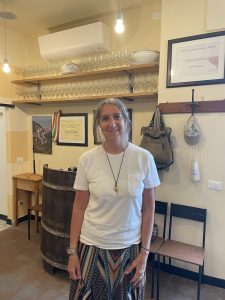
Yvonne Riccobaldi, who was born and raised in Manarola, one of the five villages and where she currently has set up her business and provides wine tastings for small groups to share her passion and expertise about the Cinque Terre wine as a sommelier. “A lot of people that come here don’t know anything about the Cinque Terre wine” She explained. Yvonne experienced the impacts of increasing tourism first hand. While she started her business in Riomaggiore, she eventually moved back to Manarola due to the arrival of too many people. She also shared how she supports her decision for the small groups during her tastings; “I provide wine tastings with less people to make sure they fully understand are interested.”
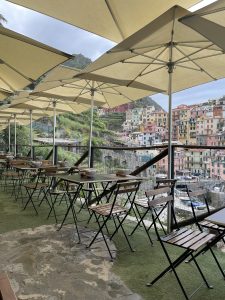
The view from Nessun Dorma’s Terrace onto Manarola
In the same village, Simone Livadoti manages one of the most popular restaurants of the Cinque Terre, Nessun Dorma. The restaurant located on the cliff side provides a breathtaking view on the city located on the valley. However, before Nessun Dorma was opened in 2014, the area had been closed and neglected for quite some time. The mayor wanted to utilize the area again, which resulted in setting up a contest in which Simone along 2 other companies participated, the best idea would be rewarded with the area and had to work out the idea. “When I was 24 years old, I won the contest and had to set it up” he shared. The restaurant wasn’t as popular as it is now; “It was me and just 2 people sitting on this long table and the rest of the restaurant was empty, now we have 3 stores.”
Seasonal changes
The tourism season in the Cinque Terre usually runs, depending on the weather, from April to October. But during this season, residents often experience difficulties in their everyday life. “It’s too busy, for my business it’s okay because I work with small groups, but as a person that lives here it’s too busy” Yvonne shared. Tourists arrive from all over Italy, with busses from Florence or Pisa, the cruise ships that stop in La Spezia, or the train from Levanto to La Spezia, which runs through all the five villages. “They cross our roads and it’s impossible to walk, take a coffee or meet people” Yvonne adds. However, during winter season it does not seem to improve, the streets turn quiet again, but the shops and restaurants tend to close their doors. “In Manarola, during Winter there is normally only 1 bar or restaurant open” Yvonne mentioned.
Restaurants in the Cinque Terre are a fast-paced business, with a lot of people coming to visit, there immediately are also a lot of people that need a place to eat. Time is of the essence, “in the kitchen, there is often no time, which means a lot of pasta’s are frozen, just to be ready in 2 minutes” Simone shared. The quality of ingredients is often also in question. “Restaurants have to make a lot of money, and the quality of ingredients is therefore not good” Yvonne mentioned.
- Tourists in Cinque Terre crossing the narrow streets.
- Tourists in Cinque Terre crossing the narrow streets.
Protecting the national park
According to a presentation published by Europarc Federation, an organisation working towards sustainable tourism in protected areas, together with Parco Nazionale Delle Cinque Terre, managing mass tourism in the region is a battle which has been going on for quite some time (Terre & Europarc, 2019). The presentation demonstrates ways in which the park has been trying to get a better foothold on mass tourism through various initiatives. In order to support local agriculture, the park collaborates with an organization uniting 300 wine makers to produce an annual amount of 160,000 bottles of wine, preserving traditional farming practices and the iconic landscape of the Cinque Terre.
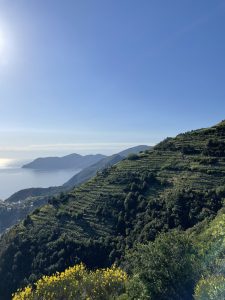
The vineyards on the cliffside of the national park.
The park also introduced the Environmental quality label (ECST, Phase II) ensuring that tourist accommodations adhere to sustainability standards. While in 2019, 19 private businesses carried the label, in 2024 this number has grown to 136 businesses (Parco Nazionale Delle Cinque Terre, 2024). Furthermore, the park distributes hikers across less crowded trails and uses sensors to monitor popular paths. Finally, the park works with the Cinque Terre Card, which allows tourists, after purchase, to travel between the villages with public transport and provides access to the park’s official trails. Through these initiatives the park aims to protect the unique environment and cultural heritage while simultaneously supporting the local communities.
Producing Cinque Terre Wine
Part of the allure which attracts tourists to the Cinque Terre region are the beautiful vineyards that stretch across the rugged coastline. The vineyards are located on the terraced hillsides which are supported by dry stone walls. Due to the steep terrain, mechanized labour is limited making it necessary for workers to hand pick the grapes. Eventually a monorail system is used to move the harvested grapes. The circumstances surrounding the climate do not contribute to making the production of wine easier, as the summer months are often dry. “We have to train the grapes, to make sure the roots grow down to get water and minerals from the soil” Alessandro Barrani shared during a tour of is vineyards.
- The grapes growing at the vineyard
- A small look into the Cinque Terre wines
Innovation & Adaptation
- The endless possibilities for take away.
- The endless possibilities for take away.
- The endless possibilities for take away.
The high influx of people asks for new and innovative ways to do business to attract, retain and accommodate tourists. While the streets are filled with people drinking wine and Aperol Spritz out of plastic cups, as well as the slices of pizza and focaccia being served on napkins, merely to avoid sitting down and continuing the day sightseeing in the Cinque Terre. While there is no specific However not all businesses comply to this way of doing business. “Wine from Cinque Terre is difficult to prepare, it’s a hard job, hard work. So, when you drink it, you have to understand it” Yvonne shares as she explains her reason to not offer her wines for take-out. But it does not stand in her way of attracting business, through connections with tour guides and pre booked wine tastings, she still attracts the tourists fully interested in exploring all there is about the Cinque Terre wines.
As for Simone, while the popularity of Nessun Dorma has grown throughout the years, so did the necessity to expand the business. “I decided to make this place without reservations, everyone should be able to come by and visit” Simone mentioned. However, as lines started to grow and people had to wait in line for hours to get a table at Nessun Dorma, a change had to be made. “Me and two engineers developed an app, so you don’t have to stay outside and wait for 5 hours” He shared. The app allows customers to enter a digital queue and spend their day as they prefer, as soon as the number gets closer, they get a notification to come to the restaurant.

The app icon for the Nessun Dorma app in order to wait in the queu.
Gastronomy in the Cinque Terre
Gastronomy in the Cinque Terre has also made its way on to the routes of tourists. The region is renowned for its cooking classes, which provide hands-on experiences in traditional Ligurian cuisine. The classes often take place in a variety of settings, including hotels, restaurants, and professional culinary schools. Tourists can choose between a wide array of cooking classes in which they learn to make things such as pesto, fresh seafood and homemade pasta while simultaneously engaging with local culture. These experiences allow tourists to connect with the regions heritage while creating memories and visiting the region (Kokkranikal & Carabelli, 2021).
- The fresh made pesto.
- Simone Livadoti during his pesto making class.
- The small joyful parties during a pesto class.
- Tourists making pesto during a pesto class.
Towards a balanced future
The Cinque Terre has been battling mass tourism for quite some time, with thousands of tourists visiting on a daily basis, and without the expectation of those numbers diminishing in the near future, the park, locals, and businesses had to find ways to adapt.
Innovative solutions like Simone Livadoti’s restaurant app and Yvonne Riccobaldi’s small-group wine tastings show how technology and tailored experiences can alleviate the effects of high tourist influx. The park’s initiatives, such as the Environmental Quality Label and the Cinque Terre Card, demonstrate a commitment to sustainable tourism that balances economic benefits while preserving natural and cultural heritage.
While challenges remain with seasonal fluctuations affecting local life, infrastructure and economy. The Cinque Terre and its residents are working hard to provide new ways of doing business and adapting to the changing scene. With thoughtful planning and community involvement, a balance between tourism and preservation can be achieved, ensuring the region’s unique charm and character are maintained for future generations.
